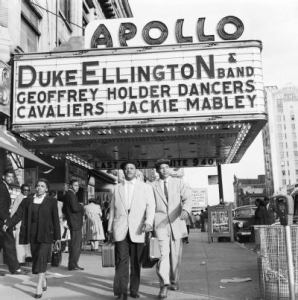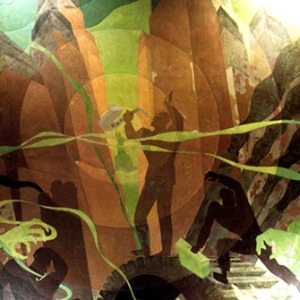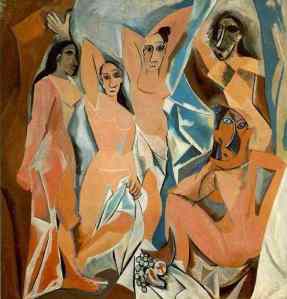 After the end of the Civil war many things changed in the artistic world. There were many political growths and developments at this time, one of which could be considered one of the most influential developments pertaining to art in the Early modern Era. This is of course is, The Harlem Renaissance, and the influence the African-American community and culture had on the art of this time period. As more and more African-Americans traveled north to better themselves with economic opportunity the district of Harlem, in New York City began to grow as a focal point of art throughout the 1900s. Through the Harlem Renaissance numerous new plays, novels, artwork, music, and dance styles were being produced, all of which represented the African-American culture and influenced, as well as, effected the other cultures surrounding them. The Harlem Renaissance helped to lay a foundation for the turning point in the artistic culture of the Early Modern Era, by laying down a foundation for the future African-American artists, and all other artists and viewers, to be inspired by the cultural and artistic revolution that the Harlem Renaissance and the African-American people created.
After the end of the Civil war many things changed in the artistic world. There were many political growths and developments at this time, one of which could be considered one of the most influential developments pertaining to art in the Early modern Era. This is of course is, The Harlem Renaissance, and the influence the African-American community and culture had on the art of this time period. As more and more African-Americans traveled north to better themselves with economic opportunity the district of Harlem, in New York City began to grow as a focal point of art throughout the 1900s. Through the Harlem Renaissance numerous new plays, novels, artwork, music, and dance styles were being produced, all of which represented the African-American culture and influenced, as well as, effected the other cultures surrounding them. The Harlem Renaissance helped to lay a foundation for the turning point in the artistic culture of the Early Modern Era, by laying down a foundation for the future African-American artists, and all other artists and viewers, to be inspired by the cultural and artistic revolution that the Harlem Renaissance and the African-American people created.
The Influence of African-Americans on Visual Arts
Aspects of Negro Life: Song of the Towers By Aaron Douglas (1934)
During the Early Modern Era the African-Americans had a huge impact on the visual arts being produced at the time. It was the beginning of the artistic world in which the African-American culture was at the center of the subject matter being portrayed through paintings, sculptures, and photographs. Art began to start to capture the lives of African-Americans focusing on their history and trying to depict their lifestyle. It started to allow African-American artists to become a prominent figure in the art world of the 1900s as well. We see artists such as Aaron Douglas painting murals depicting the African-American culture, history, and place in the society of the early 19th century. My Reaction to the Artwork, and How it is Influenced by the African-American Culture Overall, I think Aspects of Negro Life: Song of the Towers by Douglas is such an inspirational and beautiful piece. The way Douglas captures the essence of the African-American people and culture through the depiction of the saxophone and the feel of the scenery is impeccable. There is this feeling of triumph when looking at the figure throwing his hands up in the air between these two towering rock structures, yet there is also this clashing feeling of insecurity due to the way the men are merely shadows and not detailed figurines. It as is something is missing, and we are not getting the whole story. It is beautifully off-putting. It establishes the want to rejoice, but question to if that is possible. This painting is obviously incredible influenced by the African-American culture due to many different facts. First off, Aaron Douglas was of African-American decent so he had a firsthand understanding of the history and culture of his people. He used this understanding to create morals such as, Aspects of Negro Life: Song of the Towers, that spoke about the African-American history and the issues they faced in the society of the 1900s. In this painting, Douglas brings forth the issue of racism with the African-American man standing in the enter, hands up, yet this almost target like shape cascading over him. The influence of the African-American people is impossible not to see in this painting, and it begins to open up a whole new category to the art of the 19th century.
Les Demoiselles d’Avignon by Pablo Picasso (1907)
My Reaction to the Artwork Les Demoiselles d’Avignon by Pablo Picasso is an extremely interesting piece. It is hard to put a finger on what stands out to me the most because there is so much going on in the painting. I really enjoy the contrast of the sharp lines and edges of the individual aspects of the picture with the overall view of the painting. For instance, even though Picasso uses jagged edges and sharp lines the bodies of the women still look so curvy and smooth. There is this mesmerizing elegance put on the women that is hard to take your eyes of off. It is also extremely interesting to look at how disconnected the faces of the women are from their bodies even though they are connoted. There is this dissonance between them that establishes this sort of barrier between the two, which is very thought-provoking. Picasso had a strong fascination with the artistic African art that he translated into his own art. Les Demoiselles d’Avignon was the beginning to this period of fascination he had with the African art. The two figures on the right side of this painting were directly influenced by the African art that inspired him to begin painting in this style, which lasted for several years and became known as Picasso’s “Negro Period” or “Black Period”
Porgy and Bess
The Harlem Renaissance, and the African-American culture developed many artistic advances with music, such as Jazz and Blues, and aided in the developed subject matter of paintings and sculptures, but they also had a huge effect on musical composers and theatre performances, specifically musical theatre, during the 19th century. In the Early Modern Era, it was very unlikely to have a Musical, Opera, or theatre performance containing African-American actors and singers, especially not as the leading man or lady, but during this period that changed.
The famous American music composer and lyricist, George Gershwin, was so inspired by African-American Jazz and Blues songs, that he went on to adapt DuBose Heyward‘s novel Porgy into a folk opera, that would premiere in New York City, September 30th, 1935. Porgy and Bess featured an entire cast of classically trained African-Americans, which was an extremely unusual and risky artistic choice at the time. Porgy and Bess became the best known and most frequently done operas of its time.
My Reaction to the Artwork, and How it is Influenced by the African-American Culture
I absolutely love Porgy and Bess. I think it is a classic piece of musical theatre that has heart and soul, and arouses the audiences emotions even today. The song “Summertime” is one of my favorite songs of a Gershwin musical to listen to. It is so beautifully haunting that the tune seems to stay with you forever. The song it is written just so that it creates this beautiful nostalgic feeling that makes you calm, and relaxed, yet alert and ready to begin. It is a movies piece of music and theatre that really changed history, as well as, change the place for African-Americans in the theatre.
Porgy and Bess was incredibly influenced by the African-American culture of the 19th century , and without it, it is possible that this folk opera might not have ever been composed. Like previously stated, George Gershwin was inspired by the Jazz and Blues music created by the African Americans, and this inspiration lead him to compose this opera. Not only did the African culture influence the creation of the piece but it also influenced the storyline and themes of the piece. Porgy and Bess revolves around the trials and tribulations of African American main characters and their stories, which was an ongoing influence on the art of this time period.
Overall, the art of the Early Modern Era was highly influenced by the African-American people and their culture. Without the Harlem Renaissance, and all the contributions made by African American artists during this time period, its safe to say that the art that is so highly recognized and cherished created in the 19th century would be incredibly different.
Works Cited
“Aaron Douglas, Jazz Roots: Art Gallery.” Aaron Douglas, Jazz Roots: Art Gallery. Web. 2 Apr. 2015. <http://xroads.virginia.edu/~asi/musi212/brandi/douglas.html>.
“Aaron Douglas.” Virtual Exhibition. 22 Apr. 2013. Web. 2 Apr. 2015. <https://art257virtualexhibitionyb.wordpress.com/aaron-douglas/>.
Bio.com. A&E Networks Television. Web. 2 Apr. 2015. <http://www.biography.com/people/aaron-douglas-39794#later-career>
“Black American Artists – Harlem Renaissance – Artist Value.” Black American Artists – Harlem Renaissance – Artist Value. Web. 2 Apr. 2015. <http://www.askart.com/AskART/interest/black_american_artists_1.aspx?id=33>.
“Heilbrunn Timeline of Art History.” African Influences in Modern Art. Web. 2 Apr. 2015. <http://www.metmuseum.org/toah/hd/aima/hd_aima.htm>.
“Picasso’s African Period.” Wikipedia. Wikimedia Foundation. Web. 2 Apr. 2015. <http://en.wikipedia.org/wiki/Picasso’s_African_Period>.
“Pablo Picasso.” ‘s African-influenced Period. Web. 2 Apr. 2015. <http://www.pablopicasso.org/africanperiod.jsp>.
“The Harlem Renaissance – Boundless Open Textbook.” Boundless. Web. 2 Apr. 2015. <https://www.boundless.com/art-history/textbooks/boundless-art-history-textbook/europe-and-america-1900-1950-36/america-1930-1945-228/the-harlem-renaissance-809-10846/>.
Web. 2 Apr. 2015. <https://art-mus-thr200.community.uaf.edu/2009/04/24/03-visual-art-2/>.
Web. 2 Apr. 2015. <https://art-mus-thr200.community.uaf.edu/2009/04/24/04-music-5/.



What a great topic to elaborate on! The Apollo Theater is an amazing establishment that showcases the African American influence in our country. One thing that I found is that in “(…)1983, the Apollo received state and city landmark status(…).” (The Apollo Theater, 2014) Also, according to the Apollo Theater website both Lena Horne and Billie Holiday made their debut at the Apollo Theater; both of these women are powerhouses in the American Culture. Black and white photographs peek my interest; the photo of the Apollo Theater that you have displayed is superb. The photograph was probably taken to advertise the show that was playing that night. We now look at these photos as milestones in the American history. What was once viewed as utilitarian is now being viewed as a precious moment in history. https://www.apollotheater.org/the-thirties
LikeLike
What a great topic to elaborate on! The Apollo Theater is an amazing establishment that showcases the African American influence in our country. One thing that I found is that in “(…)1983, the Apollo received state and city landmark status(…).” (The Apollo Theater, 2014) Also, according to the Apollo Theater website both Lena Horne and Billie Holiday made their debut at the Apollo Theater; both of these women are powerhouses in the American Culture. Black and white photographs peek my interest; the photo of the Apollo Theater that you have displayed is superb. The photograph was probably taken to advertise the show that was playing that night. We now look at these photos as milestones in the American history. What was once viewed as utilitarian is now being viewed as a precious moment in history. https://www.apollotheater.org/the-thirties
LikeLike